The telescope is a fantastic instrument for Astro-research, astrophotography of the universe, and amateur astronomy lovers. A few decades ago, people did not know about the universe. Because telescopes were out of reach of the available people, researchers used them for researching space.
But nowadays, telescopes are smaller in size and affordable for the mass people. A telescope can collect light from the farthest object and magnify the image; thus, we can see it closer. Now the question comes – how do the Telescopes work? This article will explain each part of a telescope’s significance and how these parts work together to make a perfect image of the objects.
Basics of Telescopes:Significant Parts and Their Role
As we delve into the fundamental workings of telescopes, it’s essential to comprehend the intricacies of these cosmic windows. Picture yourself beneath the star-studded canvas of the night sky, armed with a telescope poised to reveal the wonders of the cosmos. The foundation of this awe-inspiring experience lies in the basic principles of telescopes, where lenses and mirrors dance harmoniously to capture the brilliance of distant celestial bodies.

- Types of Telescopes:
- Refracting Telescopes:The classic refracting telescope, reminiscent of Galileo’s pioneering instrument, employs lenses to bend and converge light. This type of telescope boasts simplicity in design and is often favored by beginners for its ease of use. The table below provides a snapshot of key features and considerations for refracting telescopes:FeatureDescriptionObjective LensGathers and focuses light onto the eyepiece.EyepieceMagnifies the focused image for observation.Mounts and TripodsProvide stability and support for the telescope.
- Reflecting Telescopes:Reflecting telescopes, on the other hand, embrace mirrors to capture and redirect light. This design, popularized by Sir Isaac Newton, offers distinct advantages in terms of image quality and versatility. The table below outlines key aspects of reflecting telescopes:FeatureDescriptionMirrorsCapture and reflect light for image formation.Optical DesignEliminates chromatic aberration.VersatilityWell-suited for various celestial observations.
- Components of Telescopes:
- Objective Lens:The objective lens plays a pivotal role in gathering and focusing light. Its diameter, known as the aperture, determines the telescope’s light-gathering capability. Larger apertures unveil fainter celestial objects, making them visible to the observer. Below is a table highlighting the significance of aperture size:Aperture Size (in inches)Observational CapabilityLess than 3Suitable for lunar and planetary observations.3 to 5Captures brighter deep-sky objects.6 and aboveReveals faint galaxies and nebulae.
- Eyepiece:The eyepiece serves as the magnifying lens, allowing observers to scrutinize distant celestial objects. The choice of eyepiece influences the telescope’s magnification, impacting the clarity and detail of the observed images. The table below offers insights into the relationship between eyepiece focal length and magnification:Eyepiece Focal Length (mm)Magnification Formula4 to 6Low magnification for wide-field views.8 to 12Moderate magnification for clarity.14 and aboveHigh magnification for detailed views.
- Mounts and Tripods:Stability is paramount for effective observation, and mounts and tripods provide the necessary support for telescopes. The choice between equatorial and altazimuth mounts depends on the observer’s preference and the type of celestial tracking required. The table below highlights considerations for selecting mounts:Mount TypeFeaturesEquatorial MountFacilitates tracking celestial objects.Altazimuth MountSimpler design, suitable for casual observers.
These tables and statistical insights serve as valuable guides for enthusiasts embarking on their astronomical journey. Whether you opt for the classic elegance of a refractor or the versatility of a reflector, understanding these telescope basics empowers you to navigate the cosmic seas with confidence.
| Aperture/Objective lens/Primary lens | A telescope allows you to see the farthest object that can’t be seen with your bare eyes. To do that, a telescope must collect light/electromagnetic radiation from those objects. An aperture or primary lens does this task for a telescope. The bigger your aperture/primary mirror, the more light it collects from the objects. As the bigger aperture can collect more light, you should choose the more significant gap. |
| Magnification Power | You know that a telescope gives you a closer & detailed look at the farthest objects, and this zooming depends on the magnification power. You may hear about the eyepiece. The eyepiece magnifies the distance of the image. The magnification depends on the eyepiece. |
| Focal Point | The focal point is the main point of your focuser. The eyepiece needs to be at the focal point to focus correctly. A good focus is always important to get a clear and still image. |
| Eyepiece | That’s called an eyepiece because the eyepiece is the closest part of the telescope to your eyes when you see through a telescope. It is the nearest part to the focal point. It helps to magnify the objects. You can get the magnification power by dividing the telescope’s focal length by the eyepiece focal length. |
| Focal tube | This tube holds the parts of the telescope. The optical elements of a telescope are placed inside the line. It keeps the optical parts safe from physical damage. The eyepiece, finder scope, and lenses/ mirrors are all attached to it. |
| Mount | To set up your telescope, you need support or a stand. This stand is called a Mount. A Telescope mount is essential for stability and good focusing. There are mainly two types of telescope mount: The Equatorial mount and the Altazimuth mount. The equatorial mounts are the computerized mount, and the Altazimuth mount is the manual version of the support. But manual and automatics don’t matter; first, you must ensure stability by ensuring the mount is strong enough. |
| Finder Scope | To observe any objects, primarily, you need to find the object. In a telescope, there is a finder scope by which you can find the objects. |
| Focuser | The focuser helps you focus on the object’s center; thus, you can get a clearer and more detailed image. |
Optics Behind Telescopes: Unraveling the Cosmic Symphony
As we peer through the lenses and mirrors of telescopes, the magic of optics unfolds, revealing the intricate dance of light that brings celestial wonders into focus. Understanding the optics behind telescopes is akin to deciphering a cosmic symphony, where each note plays a crucial role in the grand composition of the universe.
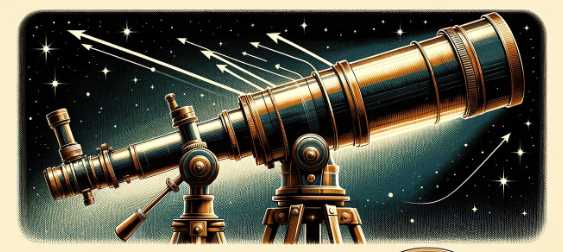
- Light-Gathering Ability and Aperture:The primary element influencing a telescope’s prowess is its aperture—the diameter of its light-collecting lens or mirror. A larger aperture translates to a greater ability to gather light, unveiling fainter celestial objects. The table below provides a glimpse into the relationship between aperture size and observational capability:Aperture Size (in inches)Observational CapabilityLess than 3Suitable for lunar and planetary observations.3 to 5Captures brighter deep-sky objects.6 and aboveReveals faint galaxies and nebulae.
- Focal Length and Magnification:Focal length and magnification go hand in hand, shaping the observer’s experience. The focal length represents the distance between the telescope’s lens or mirror and the point where light converges to form an image. The magnification factor, influenced by the eyepiece, determines how much the image is enlarged. The table below outlines the impact of different eyepiece focal lengths on magnification:Eyepiece Focal Length (mm)Magnification Formula4 to 6Low magnification for wide-field views.8 to 12Moderate magnification for clarity.14 and aboveHigh magnification for detailed views.
- Understanding Aberrations and Correction:Despite the marvels of optics, telescopes are susceptible to aberrations—imperfections that distort images. Two common types are chromatic aberration, causing color fringing, and spherical aberration, leading to distorted shapes. Fortunately, innovative correction techniques exist. The table below provides insights into addressing aberrations:Aberration TypeCorrection TechniqueChromatic AberrationAchromatic or apochromatic lens design.Spherical AberrationParabolic mirror or multiple mirror designs.
The symphony of optics within telescopes harmonizes to produce breathtaking cosmic vistas. Whether you’re exploring lunar craters or delving into the depths of distant galaxies, the principles of optics guide your celestial journey. As you choose a telescope with the right aperture, focal length, and correction techniques, remember that each optical element contributes to the immersive experience of unveiling the mysteries of the cosmos. Let your telescope be the conductor, orchestrating the cosmic ballet that unfolds with each glance into the vastness of space.
Types of Telescopes and Their Applications: Navigating the Cosmic Spectrum
Telescopes, like cosmic tools, come in various forms, each tailored to unravel specific facets of the universe. Whether you seek to explore distant galaxies, capture planetary details, or delve into radio frequencies, understanding the types of telescopes and their applications is key to unlocking the mysteries of the cosmos.
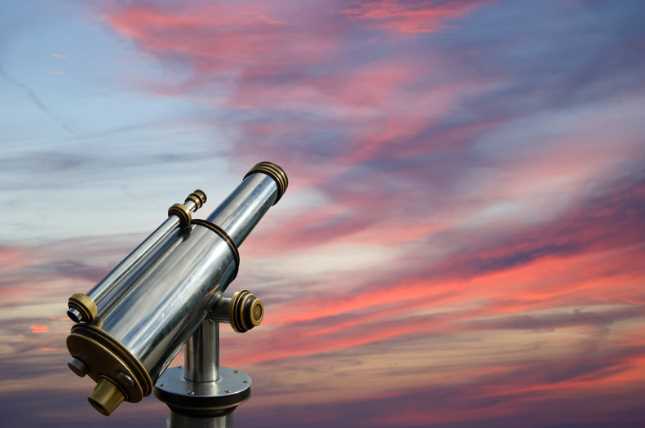
- Optical Telescopes:Optical telescopes utilize visible light to capture and magnify images. Within this category, there are two primary types—refractors and reflectors. Refractors, with lenses, offer crisp images, making them ideal for planetary observations. Reflectors, employing mirrors, excel in capturing fainter celestial objects. The table below provides insights into the applications of optical telescopes:Telescope TypeCharacteristicsApplicationsRefractingRelies on lenses to gather and focus light.Ideal for lunar, planetary, and double star observations.ReflectingUtilizes mirrors for light capture and reflection.Excellent for deep-sky observations like galaxies and nebulae.
- Radio Telescopes:Venturing beyond the visible spectrum, radio telescopes detect radio frequencies emitted by celestial objects. This type of telescope unveils a universe not perceivable by the human eye. The table below outlines the characteristics and applications of radio telescopes:Telescope TypeCharacteristicsApplicationsRadioCaptures radio frequencies emitted by celestial objects.Ideal for studying quasars, pulsars, and cosmic microwave background radiation.
- Space Telescopes:Orbiting high above Earth’s atmosphere, space telescopes overcome atmospheric interference, delivering unparalleled clarity and precision. The Hubble Space Telescope stands as a testament to the capabilities of these cosmic observatories. The table below provides insights into the characteristics and applications of space telescopes:Telescope TypeCharacteristicsApplicationsSpaceOrbits above Earth’s atmosphere, avoiding atmospheric distortion.Captures high-resolution images of distant galaxies, nebulae, and more.
Each type of telescope offers a unique lens into the cosmos, catering to astronomers’ diverse needs. Whether you’re fascinated by the intricate details of planets, the subtle glow of nebulae, or the enigmatic signals of radio waves from the universe, there’s a telescope designed to unveil the cosmic wonders that capture your imagination. As technology advances, telescopes continue to push the boundaries of our exploration, offering ever more profound glimpses into the vast tapestry of the universe.
Telescopes in Different Wavelengths: Illuminating the Unseen Cosmos
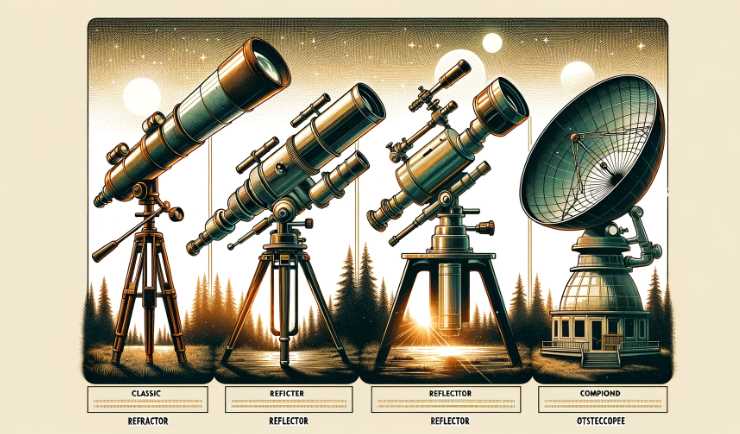
Overview of the Electromagnetic Spectrum:
Before we embark on the fascinating realm of telescopes exploring beyond visible light, let’s grasp the expansive nature of the electromagnetic spectrum. Spanning from radio waves to gamma rays, the electromagnetic spectrum encapsulates a vast array of wavelengths. Each wavelength unveils unique information about the cosmos, contributing to our comprehensive understanding of the universe.
Telescopes Beyond Visible Light:
- Infrared Telescopes:Infrared telescopes peer into the universe using longer wavelengths than visible light. This enables them to detect heat signatures rather than visible light, making them invaluable for observing cool objects like distant galaxies and molecular clouds. The table below highlights the characteristics and applications of infrared telescopes:Telescope TypeWavelength RangeApplicationsInfraredBeyond the visible spectrumIdeal for studying cool astronomical objects such as dust clouds and star-forming regions.
- Ultraviolet Telescopes:Ultraviolet telescopes explore shorter wavelengths than visible light, unveiling the energetic processes within celestial objects. These telescopes are instrumental in studying hot stars, active galactic nuclei, and the dynamics of stellar atmospheres. The table provides insights into the characteristics and applications of ultraviolet telescopes:Telescope TypeWavelength RangeApplicationsUltravioletShorter than visible lightUseful for studying hot stars, quasars, and the interstellar medium.
- X-ray Telescopes:X-ray telescopes delve into extremely short wavelengths, enabling the observation of highly energetic phenomena such as black holes, supernovae, and hot gas in galaxy clusters. The table outlines the characteristics and applications of X-ray telescopes:Telescope TypeWavelength RangeApplicationsX-rayVery short wavelengthsIdeal for studying high-energy processes like accretion onto black holes and supernova remnants.
Importance of Multi-Wavelength Observations:
The universe communicates through various wavelengths, each unveiling a unique facet of its cosmic symphony. Multi-wavelength observations, combining data from different telescopes, provide a comprehensive understanding of astronomical phenomena. By embracing the entire electromagnetic spectrum, astronomers gain a holistic perspective, unraveling the intricate interplay of cosmic forces and phenomena. This approach ensures that no celestial secret remains hidden, allowing us to paint a vivid portrait of the cosmos in all its diversity and splendor.
Tips for Amateur Astronomers: Navigating the Cosmos with Confidence
Choosing the Right Telescope for Beginners:
Astronomy, a celestial adventure awaiting eager eyes, begins with selecting the perfect telescope. As a beginner, it’s crucial to consider both budget constraints and your experience level. The market offers a variety of telescopes suited for different needs, from affordable yet reliable options for novices to more advanced models for those ready to delve deeper into the cosmos. The table below outlines key considerations:
| Consideration | Description |
|---|---|
| Budget | Determine a reasonable budget for your first telescope. |
| Experience Level | Choose a telescope that aligns with your level of expertise. |
Proper Maintenance and Cleaning Techniques:
Maintaining the pristine condition of your telescope ensures optimal performance and longevity. Regular cleaning, though delicate, is a necessary part of telescope care. When cleaning lenses and mirrors, follow these steps:
- Cleaning Lenses and Mirrors:
- Use a soft brush or air blower to remove loose dust particles.
- Gently wipe the surface with a lens-cleaning solution and a microfiber cloth.
- Avoid excessive pressure to prevent scratching delicate surfaces.
- Storing Telescopes Safely:
- Keep your telescope in a protective case or bag when not in use.
- Store it in a dry, cool place to prevent damage from humidity or extreme temperatures.
Star Charts and Navigation Tools for Effective Sky Observation:
Navigating the celestial expanse requires more than just a telescope; it demands a celestial roadmap. Utilizing star charts and navigation tools enhances your sky-watching experience. Consider these tips:
- Star Charts:
- Invest in star charts or use mobile apps to identify constellations and celestial objects.
- Familiarize yourself with prominent stars and landmarks in the night sky.
- Navigation Tools:
- Employ tools like red LED flashlights to preserve night vision while reading star charts.
- Consider a computerized telescope mount for automated tracking.
How Do Telescopes Work?
Generally, people use an optical telescope for astronomy or astrophotography. There are three modern optical telescopes; the telescope, the Refractor telescope, the Reflector telescope, and the Catadioptric telescope. The mechanisms are also different in these types. They work in various methods. Now we will explain the working procedure of each type one by one:
How Do the Reflecting Telescopes work?
A reflecting telescope is also called a Newtonian telescope. This type is different from other types because it uses a big concave curved mirror at the lens’s place. This concave mirror is placed at the back of the focal tube, and the line is not like another telescope tube; it is open.
Primarily, you have to find the object you want to observe by a finder scope and focus it accurately. The big mirror/larger aperture at the back collects the light from the objects to produce brighter images. (Infographic)
The primary mirror then reflects the light to the secondary mirror; finally, it turns the eyepiece. The eyepiece magnifies the objects; thus, you can see the image in front of your eyes. (Infographic)
Subsequently, the image of the object comes from the detector or CCD. You can observe the beautiful night sky and the deep sky objects with a reflector telescope. (Infographic)
How Do the Refracting telescopes work?
A Refracting telescope has a longer tube than a reflecting telescope. It contains two lenses; one is a primary lens, and the other is a secondary one. Both of the lenses are Convex shaped.
The object-finding and focusing processes are quite the same. But this process is straightforward. The primary lens is at the front. After collecting the objects’ lights by the primary lens, the light directly goes to the secondary lens through the long thin tube.
Then it goes to the eyepiece, and the eyepiece magnifies the objects. Finally, we see the objects in the detector.
The refractor telescope is easier to use than the reflector telescope. They’re suitable for observing celestial objects like the moon and the planets in the night sky.
How Does the Catadioptric Telescope work?
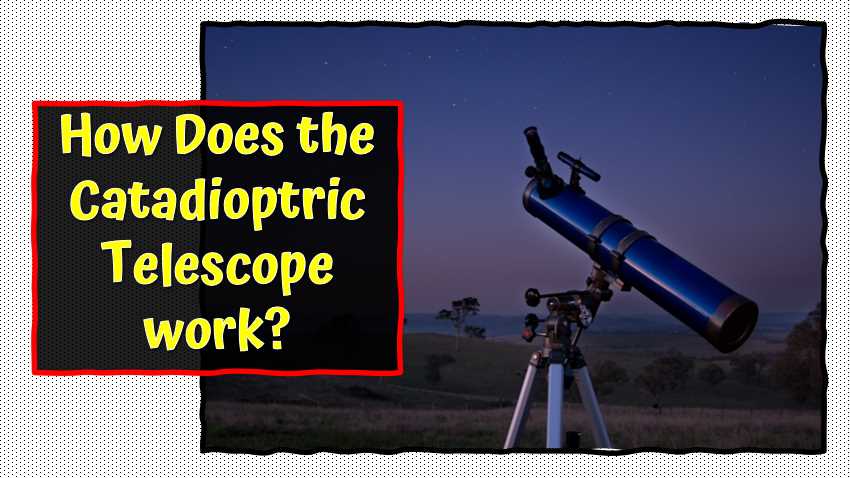
The Catadioptric telescope is a kind of compound telescope. Previously, we have seen that the refractor telescope uses a lens, and the reflector uses the mirror as an optical element. Interestingly, the Catadioptric telescope uses both mirror and lens as optical elements.
Another surprising fact is that the light first comes to the secondary lens, and crossing the secondary lens, the light comes to the primary mirror.
Conversely, in other Telescopes, the light first comes from the primary lens or mirror.
Moreover, the object finding, focusing, and looking processes are quite the same for every telescope.
Final Words:
That is how a telescope works. However, there are various telescopes. We have tried to give you an idea of the most commonly used telescopes. The works are similar for every telescope, but the working process differs. To summarize, a Reflector telescope uses a concave mirror to collect the light, and the eyepiece magnifies the distant objects.
The refractor telescope uses a lens to collect the light, and the process is relatively straightforward through a thin long focal tube. Finally, compound one – the Catadioptric telescope- uses a mirror and a lens.
The significant change is the light comes through the secondary lens to the primary mirror; contrariwise, the light first enters from the primary mirror/lens for the other two types. Magnification processes are the same for every telescope. That’s all. Thank you.
Resources and References:
For those eager to delve deeper into the cosmos, a plethora of resources awaits:
A. Books, Websites, and Documentaries:
- Explore “The Elegant Universe” by Brian Greene for a captivating journey into cosmic complexities.
- Visit NASA and the European Southern Observatory for online resources.
- Immerse yourself in documentaries like “Cosmos: A Spacetime Odyssey.”
B. Educational Institutions and Observatories:
- Harvard-Smithsonian Center for Astrophysics: Offers valuable insights and educational materials.
- Mauna Kea Observatories: A hub for astronomical research.
C. Online Communities:
- Join the Cloudy Nights forum to connect with fellow telescope enthusiasts and share experiences.

Fahim Foysal is a well-known expert in the field of binoculars, with a passion for exploring the great outdoors and observing nature up close. With years of experience in the field, Fahim has honed his skills as a binocular user and has become a go-to resource for those seeking advice on choosing the right binoculars for their needs.
Fahim’s love for the natural world began during his time at The Millennium Stars School and College and BIAM Laboratory School, where he spent much of his free time exploring the outdoors and observing the wildlife around him. This passion for nature led him to pursue a degree in Fine Arts from the University of Dhaka, where he gained a deep understanding of the importance of observation and attention to detail.
Throughout his career, Fahim has used his expertise in binoculars to help others discover the beauty of the natural world. His extensive knowledge of binocular technology and optics has made him a trusted advisor for amateur and professional wildlife observers alike. Whether you’re looking to spot rare birds or observe animals in their natural habitats, Fahim can help you choose the perfect binoculars for your needs. With his guidance, you’ll be able to explore the outdoors with a newfound appreciation for the beauty of the natural world.
Table of Contents
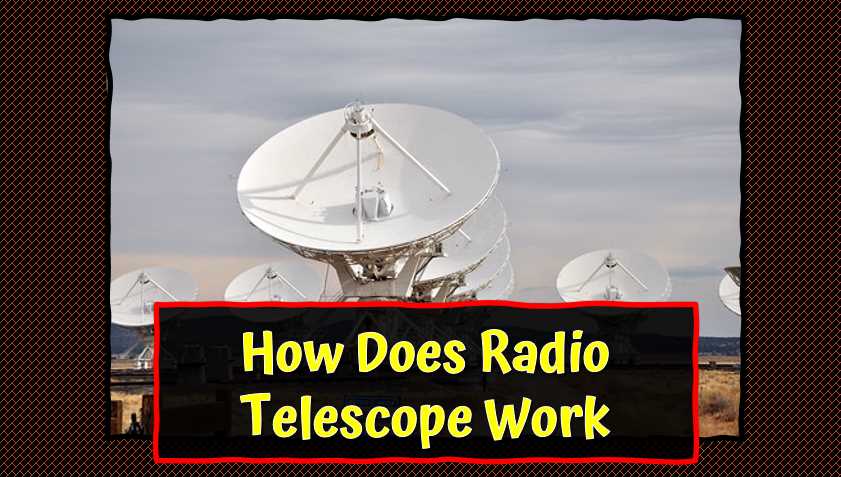
Pingback: How Does a Radio Telescope Work: Full Process in a Super Understandable Way?